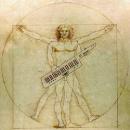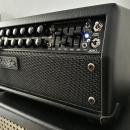No he podido meterlo en la noticia... Parece que se colapsa al cargar.
Pase de fotos en varias vistas...
http://www.attackmagazine.com/news/leaked-photos-reveal-new-roland-boutique-synths/attachment/yv2drya/#main
Roland JU-06 Synthesizer Module
The limited-edition Roland JU-06 is an authentic recreation of the iconic Juno-106 synthesizer. Sometimes described as one of the last great synths of the analog era, the Juno-106 became a favorite thanks to its warm sounds and instant sound-shaping ability. The new 4-voice JU-06 module continues this approach, with 23 parameters controllable via the front panel and that classic Juno sound -- complete with the much-loved Juno chorus effect. There are some new additions too, including a faster LFO and continuously variable hi-pass filter (HPF). You can even slide the JU-06 into the K-25m keyboard unit (not included) for a self-contained, go-anywhere synth experience.
Big Sound. Small package. The Juno-106 is sometimes described as one of the last great synths of the analog era, and it became a firm favorite thanks to its distinctive, warm sounds and instant sound shaping ability. The new JU-06 module has all of the sonic character of the original, with accurate reproduction of the entire sound set including the classic Juno strings and the much-loved Juno chorus effect.
Hands-On Control for Instant Programming The original Juno-106 was a great way to learn about synthesis, as each stage of the sound creation process was clearly laid out on the front panel, with lots of sliders for instant sound-shaping and experimentation. And that's still the case with the JU-06, which features 23 knobs and sliders from the original -- all inviting you to start tweaking and creating your own customized version of this legendary sound engine.
Additional Sound-Shaping Options Like the other members of the Boutique range, Roland also added a few subtle improvements that weren't found on the original models. The JU-06 gains a faster LFO and a continuously variable hi-pass filter (HPF) resulting in a super-smooth sound.
Develop Your Ideas with a 16-Step Sequencer The onboard 16-step sequencer is a sonic scratchpad that lets you try out new ideas without bringing lots of gear -- it can even be used without a keyboard. And if there's no keyboard connected, the ribbon controller lets you preview the sound, making it an ideal way to program patches quickly and easily.
Optional K-25m Keyboard Unit The JU-06 works especially well with the K-25m, an optional 25-key velocity sensitive keyboard that takes your music making to the next level. Once docked in the keyboard, the module's front panel adjusts to three positions for convenient access to the knobs and sliders.
Chain Mode The original Juno-106 was famous for big lush sounds created by its 6 oscillators/voices. The JU-06 features a chain mode that allows you to connect two JU-06 modules using the MIDI ports and create one, 8-voice synthesizer. Adding additional modules adds another 4 voices of polyphony with each module. This is especially great when controlling the JU-08 from a larger external keyboard. You can even edit the sound from the master module and control both units. Great for real-time filter sweeps and envelope adjustments.
Battery or USB Bus power Some of the best music is made away from the studio, so the Roland Boutique series runs on 4xAA batteries, ready for when inspiration strikes. Alternatively, you can power the JU-06 via USB bus power.
USB audio interface for direct recording into your DAW The built-in USB port also functions as a high-quality 24bit, 44.1 kHz audio interface, for a fast, simple and reliable way of recording directly to your DAW application. You can keep your favorite patches and sequencer patterns safe too, via the USB data backup function.
Features:
Ultra-compact recreation of the iconic Juno-106 synthesizer
Retains the feel, sound character and user interface of the original
23 of the original synth parameters controllable from the front panel
Adds several additions not found on the original Juno-106, including a faster LFO and continuously variable HPF
Chain mode allows two JU-06 to function as one 8-voice module
Highly portable for mobile music making
High-quality construction with metal front panel
Dual ribbon controllers for pitch bend, modulation, and sound preview
Battery-operated (4xAA) or USB powered
24 bit/ 44.1 kHz stereo IN/OUT USB audio interface
Built-in 0.5W mini-speaker for instant enjoyment
Compatible with optional K-25m keyboard unit
NOTE: Shown with optional K-25m keyboard.
JU-06 Specs
$299 street price Anticipated US release date: November 8, 2015
Maximum Polyphony: 4 voices
User Memory: 64 (8 patches x 8 banks)
Controllers: VOLUME knob, Ribbon controllers 1, 2
LFO Section: RATE slider, DELAY TIME slider
DCO Section:
RANGE buttons 16', 8', 4'
LFO slider
PWM slider
PWM mode switch
SQUARE, SAW buttons
SUB oscillator slider
NOISE slider
HPF Section: CUTOFF FREQ slider
VCF Section:
CUTOFF FREQ slider
RESONANCE slider
Polarity switch
ENV slider
LFO slider
KEY FOLLOW slider
VCA Section: Control signal switch, VCA level slider
ENV Section:
Attack Time slider
Decay Time slider
Sustain Time slider
Release Time slider
CHORUS Section: CHORUS 1, CHORUS 2 buttons
BANK 1--8 buttons: PATCH NUMBER 1--8 buttons, MANUAL button
Effects: Chorus: 2, Delay
Step Sequencer: 16 step, 16 pattern
Nominal Input Level: INPUT jack: -0 dBu -- Display: 7 segments, 2 characters (LED)
Connectors:
PHONES jack: Stereo miniature phone type
OUTPUT jack: Stereo miniature phone type
INPUT jack: Stereo miniature phone type
MIDI (IN, OUT) connectors
USB port: MicroB type (Audio, MIDI)
Power Supply: Rechargeable Ni-MH battery (AA, HR6) x 4, Alkaline battery (AA, LR6) x 4, USB bus power
Current Draw: 500mA (USB bus power)
Dimensions: (W x D x H) 11-13/16 x 5-1/16 x 1-3/4" (300 x 128 x 45 mm)
Weight (including batteries): 2 lbs. 2 oz. (940g)
Accessories: Owner's Manual, Leaflet "USING THE UNIT SAFELY," Alkaline battery (AA, LR6) x 4
Options (sold separately): Keyboard unit: K-25m
Weight, Dimensions, and Manufacturer Part Numbers Shipping Weight: 3 lbs Shipping Dimensions: 14 x 7 x 3 in Manufacturer Part Number (MPN): JU-06
Roland JP-08 Synthesizer Module
The legendary Jupiter-8 synth is back - as a limited-edition module no bigger than a book. Part of the Roland Boutique series, the JP-08 is all about hands-on control and that iconic Jupiter sound. With an array of 36 knobs and sliders from the original Jupiter-8 front panel, the 4-voice JP-08 is highly programmable and encourages sonic experimentation, especially with the built-in speaker and battery operation. Using Roland's acclaimed Analog Circuit Behavior (ACB) technology the JP-08 faithfully reproduces the original Jupiter-8 sounds and adds a few new twists in the form of extra LFOs and expanded VCO range. You can even slide the JP-08 into the K-25m keyboard unit (not included) for a self-contained, go-anywhere synth experience.
Huge Synth. Small Package. The Jupiter-8 was a big synth in every way; physically imposing with loads of knobs and sliders, and most importantly, a huge sound. The JP-08 retains the big sound of the Jupiter-8 but shrinks everything else - including the price - into a module measuring under 12" across.
Hands-on control With such an expressive sound engine, you'll want to shape the sounds to match your mood. With 36 of the original parameters accessible from the front panel, the JP-08 is all about hands-on control, and even users of the Jupiter-8 will quickly feel at home as the user interface and programming 'feel' is highly reminiscent of the original.
New Sound-Shaping Options Even though the JP-08 is an authentic recreation of the Jupiter-8, Roland also included a few extras. The JP-08 adds several new waveforms to the original architecture, including TRI and NOISE for the LFO and SIN for VCO-1, and both VCOs have an expanded range for even more sound shaping potential.
Develop Your Ideas with a 16-Step Sequencer The onboard 16-step sequencer is a sonic scratchpad that lets you try out new ideas without bringing lots of gear - it can even be used without a keyboard. And if there's no keyboard connected, the ribbon controller lets you preview the sound, making it an ideal way to program patches quickly and easily.
Optional K-25m Keyboard Unit The JP-08 works especially well with the K-25m, an optional 25-key velocity sensitive keyboard that takes your music making to the next level. Once docked in the keyboard, the module's front panel adjusts to three positions for convenient access to the knobs and sliders.
Chain Mode One of the killer features of the original Jupiter-8 was its ability to create huge pads, splits and layers using its 8 voices of polyphony. The JP-08 features a chain mode that allows you to connect two JP-08 modules using the MIDI ports and create one, 8-voice synthesizer, just like the original. Adding additional modules adds another 4 voices of polyphony with each module. This is especially great when controlling the JP-08 from a larger external keyboard. You can even edit the sound from the master module and control both units. Great for real-time filter sweeps and LFO effects.
Battery or USB Bus Power Some of the best music is made away from the studio, so the Roland Boutique series runs on 4 x AA batteries, ready for when inspiration strikes. Alternatively, you can power the JP-08 via USB bus power.
USB Audio Interface for Direct Recording Into Your DAW The built-in USB port also functions as a high-quality 24bit, 44.1 kHz audio interface, for a fast, simple and reliable way of recording directly to your DAW application. You can keep your favorite patches and sequencer patterns safe too, via the USB data backup function.
Features:
Ultra-compact recreation of the iconic Jupiter-8 synthesizer
Retains the feel, sound, character and user interface of the original
36 of the original synth parameters controllable from the front panel
Adds several additions not found on the original Jupiter-8, including extra waveforms, expanded VCO range
Chain mode allows two JP-08 to function as one 8-voice module
Highly portable for mobile music making
High-quality construction with metal front panel
Dual ribbon controllers for pitch bend, modulation, and sound preview
Battery-operated (4xAA) or USB powered
24 bit/ 44.1 kHz stereo IN/OUT USB audio interface
Built-in 0.5W mini-speaker for instant enjoyment
Compatible with optional K-25m keyboard unit
NOTE: Showed with optional K-25m keyboard.
JP-08 Specs
$399 street price Anticipated US release date: November 8, 2015
Maximum Polyphony: 4 voices
User Memory: Patch Preset: 8, Patch: 64
Controllers: VOLUME knob, Ribbon controllers 1, 2
LFO Section:
RATE slider
DELAY TIME slider
WAVE FORM select knob
VCO MOD Section:
LFO MOD slider
ENV MOD slider
FREQ MOD select switch
PULSE WIDTH MOD slider
PULSE WIDTH MOD select switch
VCO-1 Section:
CROSS MOD slider
RANGE select knob
WAVE FORM select knob
VCO-2 Section:
SYNC switch
RANGE select knob
FINE TUNE knob
WAVE FORM select knob
MIXER Section: SOURCE MIX knob
HPF Section: CUTOFF slider
VCF Section:
CUTOFF slider
RESONANCE slider
SLOPE switch
LFO MOD slider
ENV MOD slider
ENV switch
KEY FOLLOW slider
VCA Section: LEVEL slider, LFO MOD switch
ENV-1 Section:
ATTACK TIME slider
DECAY TIME slider
SUSTAIN LEVEL slider:
RELEASE TIME slider
Polarity switch
ENV-2 Section:
ATTACK TIME slider
DECAY TIME slider
SUSTAIN LEVEL slider
RELEASE TIME slider
KEY FOLLOW switch
Effects: Delay
Step Sequencer: 16 step, 16 pattern
Nominal Input Level: INPUT jack: -0 dBu -Display: 7 segments, 2 characters (LED)
Connectors:
PHONES jack: Stereo miniature phone type
OUTPUT jack: Stereo miniature phone type
INPUT jack: Stereo miniature phone type
MIDI (IN, OUT) connectors
USB port: MicroB type (Audio, MIDI)
Power Supply:
Rechargeable Ni-MH battery (AA, HR6) x 4
Alkaline battery (AA, LR6) x 4
USB bus power
Current Draw: 500 mA (USB bus power)
Dimensions: (W x D x H) 11-13/16 x 5-1/16 x 1-13/16" (300 x 128 x 46mm)
Weight (including batteries): 2 lbs. 3 oz. (970 g)
Accessories: Owner's Manual, Leaflet "USING THE UNIT SAFELY," Alkaline battery (AA, LR6) x 4
Options (sold separately): Keyboard unit: K-25m
Weight, Dimensions, and Manufacturer Part Numbers Shipping Weight: 3 lbs Shipping Dimensions: 14 x 7 x 3 in Manufacturer Part Number (MPN): JP-08
Roland JX-03 Synthesizer Module
The Roland Boutique JX-03 module continues the legacy of the JX-3P synth. The original model was launched when button-driven interfaces were popular, so it was designed to give immediate access to preset sounds. It was actually highly programmable though, especially when used with the PG-200 controller that added 24 rotary knobs for instant sonic sculpting. The limited-edition 4-voice JX-03 inherits all 24 knobs from the PG-200, as well as the distinctive JX tonal character. Roland also added some extras not present in the JX-3P including new waveforms, expanded DCO range and cross modulation options. You can even slide the JX-03 into the K-25m keyboard unit (not included) for a self-contained, go-anywhere synth experience.
JX-3P Sound. Built-in controller.
Often described as a forgotten classic, the JX-3P was all about instant access to big sounds, with a simple button-driven interface rather than lots of knobs and sliders. When used with the optional PG-200 controller however, the power of the highly programmable engine was revealed. The new JX-03 module recreates the panel layout of the PG-200 - including all 24 knobs - giving direct and instant access to the versatile synth architecture.
Additional sound-shaping options
Like the other members of the Boutique range, Roland also added a few subtle improvements that weren't found on the original models. The JX-03 benefits from extra waveforms and extended range for both DCOs as well as extra waveforms for the LFO. The second DCO also gets extra cross-modulation options. These additions further expand the sound creation possibilities of the battle-tested JX engine.
Develop your ideas with a 16-step sequencer
The onboard 16-step sequencer is a sonic scratchpad that lets you try out new ideas without bringing lots of gear - it can even be used without a keyboard. And if there's no keyboard connected, the ribbon controller lets you preview the sound, making it an ideal way to program patches quickly and easily.
Works with optional K-25m keyboard unit
The JX-03 works especially well with the K-25m, an optional 25-key velocity sensitive keyboard that takes your music making to the next level. Once docked in the keyboard, the module's front panel can be tilted for convenient access to the knobs and sliders.
Chain Mode
The original JX-3P was a powerful synth featuring 2 digitally controlled oscillators for each of its 6 voices. The JX-03 features a chain mode that allows you to connect two JX-03 modules using the MIDI ports and create one, 8-voice synthesizer. Adding additional modules adds another 4 voices of polyphony with each module. This is especially great when controlling the JX-03 from a larger external keyboard. You can even edit the sound from the master module and control both units. Great for real-time filter sweeps and envelope adjustments.
Battery or USB Bus power
Some of the best music is made away from the studio, so the module runs on 4 x AA batteries, ready for when inspiration strikes. Alternatively, you can power the JX-03 via USB bus power.
USB audio interface for direct recording into your DAW
The built-in USB port also functions as a high-quality 24bit, 44.1 kHz audio interface, for a fast, simple and reliable way of recording directly to your DAW application. You can keep your favorite patches and sequencer patterns safe too, via the USB data backup function.
Features:
Ultra-compact recreation of the iconic JX-3P synthesizer
Retains the feel, sound character and user interface of the original
Front panel includes all 24 knobs from the original PG-200 controller
Adds several updates not found on the original JX-3P, including extra waveforms for the LFO and both DCOs, along with extended DCO range
Chain mode allows two JX-03 to function as one 8-voice module
Highly portable for mobile music making
High-quality construction with metal front panel
Dual ribbon controllers for pitch bend, modulation, and sound preview
Battery-operated (4xAA) or USB powered
24 bit/ 44.1 kHz stereo IN/OUT USB audio interface
Built-in 0.5W mini-speaker for instant enjoyment
Compatible with optional K-25m mini-keyboard
JX-03 Specs
$299 street price Anticipated US release date: November 8, 2015
Maximum Polyphony: 4 voices
User Memory: 16
Preset Memory: 32
Controllers:
VOLUME knob
Ribbon controllers 1, 2
DCO-1 Section:
RANGE select knob
WAVE FORM select knob
FREQ MOD LFO switch
FREQ MOD ENV switch
DCO-2 Section:
RANGE select knob
WAVE FORM select knob
CROSS MOD select knob
TUNE knob
FINE TUNE knob
FREQ MOD LFO switch
FREQ MOD ENV switch
LFO DEPTH knob
ENV DEPTH knob
Polarity switch
VCF Section:
SOURCE MIX knob
HPF CUTOFF knob
LPF CUTOFF knob
RESONANCE knob
LFO MOD knob
PITCH FOLLOW knob
ENV MOD knob
ENV MOD polarity switch
VCA Section:
MODE switch
LEVEL knob
LFO Section:
WAVE FORM select knob
DELAY TIME knob
RATE knob
ENV Section:
ATTACK TIME knob
DECAY TIME knob
SUSTAIN LEVEL knob
RELEASE TIME knob
CHORUS Section: CHORUS button
BANK A, B, C buttons: PATCH NUMBER 1--16 buttons, MANUAL button
Effects:
Chorus: 1
Delay
Step Sequencer: 16 step, 16 pattern
Nominal Input Level: INPUT jack: -0 dBu
Connectors:
PHONES jack: Stereo miniature phone type
OUTPUT jack: Stereo miniature phone type
INPUT jack: Stereo miniature phone type
MIDI (IN, OUT) connectors
USB port: MicroB type (Audio, MIDI)
Power Supply:
Rechargeable Ni-MH battery (AA, HR6) x 4
Alkaline battery (AA, LR6) x 4
USB bus power
Current Draw: 500mA (USB bus power)
Dimensions: (W x D x H) 11-13/16 x 5-1/16 x 1-13/16" (300 x 128 x 46 mm)
Weight: (including batteries) 2 lbs. 2 oz. (950g)
Accessories: Owner's Manual, Leaflet "USING THE UNIT SAFELY," Alkaline battery (AA, LR6) x 4
Options (not included): Keyboard unit: K-25m
Weight, Dimensions, and Manufacturer Part Numbers Shipping Weight: 3 lbs Shipping Dimensions: 14 x 7 x 3 in Manufacturer Part Number (MPN): JX-03
(by Attack Magazine & Reddit)






 yo creo que mientras suene bien, y cada control haga lo que se supone que tiene que hacer, ese no es un problema mayor.
yo creo que mientras suene bien, y cada control haga lo que se supone que tiene que hacer, ese no es un problema mayor. 